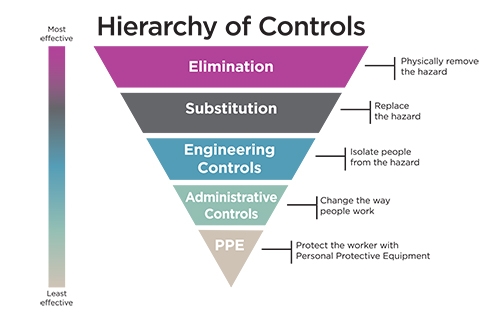 Controlling Exposure Risks from Illicit Substances
Controlling Exposure Risks from Illicit Substances
Follow these steps to control exposure risks to illicit substances in the workplace
Assess the area for hazards
Do a point of care risk assessment so you understand the risks of hazards.
Stop the work if you think it’s unsafe
- Your safety is the first priority
- Don’t enter a hazard area without proper safety measures from your risk assessment
- Follow the exposure control plan. If you don’t have one you can refuse the work until safety controls are in place.
- You have the right to refuse work when you believe it creates a safety risk. [Section 3.12 of the OHS Regulation.]
- You are not required to provide care when it's unsafe. Learn more here: Duty to Provide Care.
Report hazards to your supervisor or manager
Health Authorities:
- Report the hazard immediately to the Provincial Workplace Health Contact Centre: 1-866-922-9464
Independents & Affiliates:
- Use your employer’s hazard reporting system
Plan and implement actions from your risk assessment.
- Use the hierarchy of controls to mitigate risks and provide care only when its safe.

Alert your worksite’s BCNU JOHS Representative and Regional OHS Representative
- Email [memberportal.bcnu.org] your BCNU regional occupational safety representative. They are on the contact tab in the member portal.
- Provide a brief description of the incident so they can support you.
In January 2023, Health Canada granted an exemption from the Controlled Drugs and Substance Act to the Province of BC for a three-year period.
Since 2021, the number of reports of worker exposure have been steadily increasing. As a result, BCNU has increased focus on recreational drug exposures and the controls that can be implemented to best protect BCNU members.
Routes of Exposure
- Inhalation
- Ingestion
- Absorption
- Injection
Health Effects from Occupational Exposure to Recreational Drugs
Symptoms from exposure to chemical substances includes:
- Lightheaded
- Dizzy
- Sleepy
- Headache
- Blurred vision
- Numbness
- Increased sweating
- Feeling of warmth
- Elevated heart rate and blood pressure
- Nausea and vomiting
Risk Identification
Long-term exposure to recreational drug smoke or vapours may lead to elevated risk of illness.
Point of Care Risk Assessment (PCRA)
A PCRA is an assessment that allows a health-care worker to assess the risks that are present for both their patient, their colleagues and themselves prior to providing care. Before each patient interaction, a health-care worker must assess the following:
- The patient
- Are there additional precautions to consider?
- Has the patient been asked if they have a history of recreational drug use?
- Do you believe the patient would be able to comply with worksite policies, safely dispose of sharps, and perform routine handwashing?
- The task
- What type of task am I carrying out?
- Is additional equipment required to safely carry out the task?
- Are there additional considerations? (i.e. overdose response, oxygen administration, cleaning surfaces, disposal of substances or sharps).
- Do I need assistance?
- The environment
- Are there smoke or vapours present?
- Is there an unknown substance visible (solid, liquid or powder)
- Are there sharps present?
- Is the area safe for completing the task?
- Is there a risk to or from other individuals?
- Am I prepared?
- Do I know the safe work procedures?
- Do I have the PPE needed to prevent exposure?
- Do I have the supplies needed?
For more information on a PCRA, please visit: https://www.bcnu.org/Safe-Workplace/HealthSafety/Documents/Point_of_Care_Risk_Assesment-PCRA.pdf.
Hierarchy of Controls
| Hierarchy of Controls: from most effective to least effective | Controls |
|---|---|
| Elimination |
|
| Substitution |
|
| Engineering |
|
| Administrative |
|
| PPE |
|
Incident Reporting
Report a near miss or exposure to your supervisor via your employer’s incident reporting system.
Complete the WorkSafeBC Exposure Control Registry.
Resources
- BCCNM Duty to Provide Care
- Ministry of Health Point of Care Assessments
- Exposure Control Plans
- Recreational drugs, needlesticks, punctures, slashes
- BCNU Precautionary Principle
- Indoor Air Quality - WorksafeBC
- PPE for fentanyl
- Regulations for various hazardous substances
- Chemical and Biological Agents -- WorksafeBC
- WorkSafeBC booklet: Protecting Workers from Infectious Disease
BCNU Support
Members can submit requests for support from our membership department and occupational health and safety department – prevention team on this BCNU Support page.

